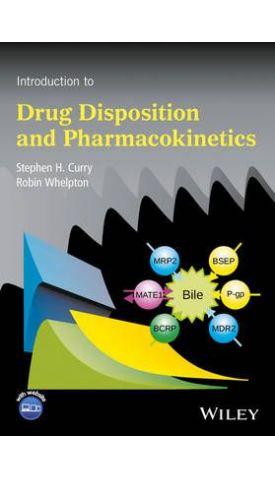אנו משתמשים ב-Cookies כדי לשפר את החוויה שלך. כדי לקיים ההנחיה החדשה של e-Privacy, עלינו לבקש את הסכמתך להגדיר את ה-Cookies. קבלת מידע נוסף.
367.00 ₪
Introduction to Drug Disposition and Pharmacokinetics
367.00 ₪
ISBN13
9781119261049
יצא לאור ב
Hoboken
זמן אספקה
21 ימי עסקים
עמודים
336
פורמט
Paperback / softback
תאריך יציאה לאור
13 בינו׳ 2017
The application of knowledge of drug disposition, and skills in pharmacokinetics, are crucial to the development of new drugs and to a better understanding of how to achieve maximum benefit from existing ones.
The application of knowledge of drug disposition, and skills in pharmacokinetics, are crucial to the development of new drugs and to a better understanding of how to achieve maximum benefit from existing ones. The book takes the reader from basic concepts to a point where those who wish to will be able to perform pharmacokinetic calculations and be ready to read more advanced texts and research papers. The book will be of benefit to students of medicine, pharmacy, pharmacology, biomedical sciences and veterinary science, including those who have elected to study the topic in more detail, such as via electives and special study modules. It will be of benefit to those involved in drug discovery and development, pharmaceutical and medicinal chemists, as well as budding toxicologists and forensic scientists who require the appropriate knowledge to interpret their findings and as an introductory text for clinical pharmacologists. Early chapters describe the basic principles of the topic while the later ones illustrate the application of those principles to modern approaches to drug development and clinical use.
Full colour illustrations facilitate the learning experience and supporting material for course leaders and students can be found on the Companion Web Site
| עמודים | 336 |
|---|---|
| פורמט | Paperback / softback |
| ISBN10 | 111926104X |
| יצא לאור ב | Hoboken |
| תאריך יציאה לאור | 13 בינו׳ 2017 |
| תוכן עניינים | Preface ix Companion Website Directions xii 1. Introduction: Basic Concepts 1 1.1 Introduction 1 1.2 Drugs and drug nomenclature 3 1.3 Law of mass action 4 1.4 Ionization 9 1.5 Partition coefficients 12 1.6 Further reading 14 2. Drug Administration and Distribution 15 2.1 Introduction 15 2.2 Drug transfer across biological membranes 16 2.3 Drug administration 22 2.4 Drug distribution 31 2.5 Plasma protein binding 38 2.6 Further reading 43 2.7 References 43 3. Drug Metabolism and Excretion 45 3.1 Introduction 45 3.2 Metabolism 46 3.3 Excretion 58 3.4 Further reading 69 3.5 References 69 4. Single compartment Pharmacokinetic Models 71 4.1 Introduction 72 4.2 Systemic clearance 74 4.3 Intravenous administration 76 4.4 Absorption 79 4.5 Infusions 87 4.6 Multiple doses 90 4.7 Non linear kinetics 94 4.8 Relationship between dose, and onset and duration of effect 98 4.9 Limitations of single compartment models 99 4.10 Further reading 100 4.11 References 100 5. Multiple compartment and Non compartment Pharmacokinetic Models 102 5.1 Multiple compartment models 102 5.2 Non compartmental models 117 5.3 Population pharmacokinetics 121 5.4 Curve fitting and the choice of most appropriate model 122 5.5 Further reading 124 5.6 References 124 6. Kinetics of Metabolism and Excretion 126 6.1 Introduction 126 6.2 Metabolite kinetics 127 6.3 Renal excretion 137 6.4 Excretion in faeces 142 6.5 Further reading 143 6.6 References 144 7. Clearance, Protein Binding and Physiological Modelling 145 7.1 Introduction 145 7.2 Clearance 146 7.3 Physiological modelling 158 7.4 Further reading 161 7.5 References 161 8. Quantitative Pharmacological Relationships 162 8.1 Pharmacokinetics and pharmacodynamics 162 8.2 Concentration effect relationships (dose response curves) 163 8.3 Time dependent models 169 8.4 PK PD modelling 173 8.5 Further reading 177 8.6 References 177 9. Pharmacokinetics of Large Molecules 178 9.1 Introduction 178 9.2 Pharmacokinetics 179 9.3 Plasma kinetics and pharmacodynamics 184 9.4 Examples of particular interest 185 9.5 Further reading 191 9.6 References 191 10. Pharmacogenetics and Pharmacogenomics 192 10.1 Introduction 192 10.2 Methods for the study of pharmacogenetics 193 10.3 N Acetyltransferase 194 10.4 Plasma cholinesterase 197 10.5 Cytochrome P450 polymorphisms 199 10.6 Alcohol dehydrogenase and acetaldehyde dehydrogenase 202 10.7 Thiopurine methyltransferase 202 10.8 Phase 2 enzymes 202 10.9 Transporters 204 10.10 Ethnicity 206 10.11 Pharmacodynamic differences 206 10.12 Personalized medicine 208 10.13 Further reading 209 10.14 References 209 11. Additional Factors Affecting Plasma Concentrations 211 11.1 Introduction 211 11.2 Pharmaceutical factors 213 11.3 Sex 214 11.4 Pregnancy 218 11.5 Weight and obesity 220 11.6 Food, diet and nutrition 225 11.7 Time of day 226 11.8 Posture and exercise 228 11.9 Further reading 231 11.10 References 231 12. Effects of Age and Disease on Drug Disposition 233 12.1 Introduction 233 12.2 Age and development 234 12.3 Effects of disease on drug disposition 242 12.4 Assessing pharmacokinetics in special populations 256 12.5 Further reading 257 12.6 References 258 13. Drug Interactions and Toxicity 260 13.1 Introduction 260 13.2 Drug interactions 261 13.3 Toxicity 273 13.4 Further reading 282 13.5 References 282 14. Perspectives and Prospects: Reflections on the Past, Present and Future of Drug Disposition and Pharmacokinetics 284 14.1 Drug disposition and fate 284 14.2 Pharmacodynamics 286 14.3 Quantification of drugs and pharmacokinetics 286 14.4 The future 289 14.5 Postscript 291 14.6 Further reading 292 14.7 References 292 Appendices 1 Mathematical Concepts and the Trapezoidal Method 293 2 Dye Models to Teach Pharmacokinetics 300 3 Curve Fitting 303 4 Pharmacokinetic Simulations 307 Index 312 |
| זמן אספקה | 21 ימי עסקים |



Login and Registration Form